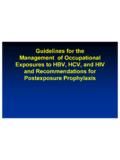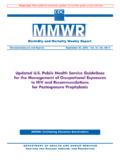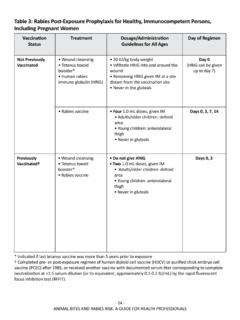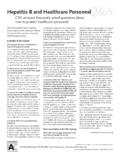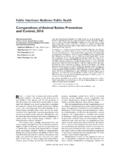Transcription of World Health Organization Guidelines on Postexposure ...
1 SUPPLEMENT ARTICLEW orld Health Organization Guidelines onPostexposure prophylaxis for HIV: recommendations for a Public Health ApproachNathan Ford1and Kenneth H. Mayer2,3; for the World Health Organization Postexposure prophylaxis GuidelineDevelopment Groupa1 Department of HIV/AIDS, World Health Organization , Geneva, Switzerland;2 Fenway Health , The Fenway Institute, and3 Department of Medicine, BethIsrael Deaconess Medical Centre and Harvard Medical School, Boston, MassachusettsThe 2014 World Health Organization (WHO) Guidelines for Postexposure prophylaxis (PEP) developed recom-mendations for PEP irrespective of exposure source in recognition of the need to simplify eligibility assessmentand prescribing practices.
2 Traditionally, separate PEP Guidelines have been developed according to exposuretype, with difference Guidelines for occupational exposure, nonoccupational exposure, and sexual assault. Rec-ognizing the need to improve uptake and completion rates for PEP, the WHO 2014 guideline does not differ-entiate between exposure sources, but rather provides recommendations across all exposures. Recommendationsfor simplifying prescribing approaches and supporting adherence are also provided. In translating this guidanceinto national PEP Guidelines , countries are encouraged to consider the need to provide PEP in a way that max-imizes uptake and completion ; Guidelines ; Postexposure prophylaxis ; World Health June 2014, the World Health Organization (WHO)convened an expert Guideline Review Group to reviewthe evidence and formulate new recommendations forpostexposure prophylaxis (PEP) for human immuno-deficiencyvirus(HIV).
3 PreviousguidelinesforHIVPEP issued by WHO in 2007 [1] were based on expertopinion and focused on HIV PEP for adults followingoccupational exposure and sexual assault; these guide-lines recommended providing a 2- or 3-drug PEP regi-men following the risk assessment of the exposure andthe potential background drug resistance at populationlevel. Antiretroviral (ARV) recommendations for HIVPEP followed WHO Guidelines for antiretroviral therapy(ART) at that time [2].The latest WHO Guidelines , released in December2014 [3], were developed based on a series of systematicevidence reviews and followed the methods of the Grad-ing of recommendations Assessment, Developmentand Evaluation, in which recommendations and theirstrength are formulated based on a formal assessmentof the quality of the evidence [4].
4 In addition to assess-ing the quality of the evidence, the WHO Guidelines de-velopment process considered additional elements ofimportance to end users such as values, preferences,feasibility, and WHO 2014 PEP Guidelines are based on thepublic Health approach to delivering HIV servicesthat seeksto ensure the widest possible access to high-quality ser-vices at a population level, aiming for a balance betweenbest proven standard of care and feasibility [5]. In thecase of PEP, the aim is to simplify prescribing andalign regimens for PEP with those currently used , separate PEP Guidelines have beendeveloped according to exposure type, with differentguidelines for occupational exposure, nonoccupationalexposure, and sexual assault.
5 Recognizing the need toimprove uptake and completion rates for PEP, the WHO2014 guideline does not differentiate between exposureaGuideline Development Group members are listed in the : Nathan Ford, PhD, World Health Organization , 20 Ave Appia,1211 Geneva, Switzerland Infectious Diseases 2015;60(S3):S161 4 The Author 2015. Published by Oxford University Press on behalf of the InfectiousDiseases Society of America. All rights reserved. For Permissions, please Guidelines for HIV PEP CID 2015:60 (Suppl 3) S161 at World Health Organization on May 25, 2015 from sources, but rather provides recommendations across all expo-sures. recommendations for simplifying prescribing approach-es and supporting adherence are also article summarizes the main recommendations of the2014 WHO PEP Guidelines , and provides references for key ev-idence reviews that underpin these ASSESSMENTE xposures Associated With HIV RiskEstimates of HIV transmission risk per act vary among popula-tion groups and are difficult to interpret due to multiple con-founding factors [6].
6 The estimated risk of HIV transmissionvia sexual exposures ranges from 4 per 10 000 exposures for con-domless insertive penile-vaginal intercourse to 138 per 10 000for condomless receptive anal intercourse [6]. The risk of percu-taneous needle stick is in the range of 23 per 10 000 exposures toan infected source [6]. Various factors may affect the risk oftransmission, including presence of other sexually transmittedinfections, plasma and anogenital viral load of the source patientif known to be HIV-infected, and circumcision status [7].Assessment of the Exposed Person s HIV StatusHIV PEP is not indicated if the exposed person is already HIV-infected. Individuals found to already be HIV-infected shouldbe referred to appropriate services for eligibility assessmentfor ART according to national Guidelines .
7 Ruling out priorHIV infection is important because in some settings PEP com-prises a 2-drug regimen, which if provided to HIV-infected in-dividuals may lead to the development of drug resistance. Insettings of lower prevalence, determination of exposure riskshould be made on a case-by-case basis. Overall, only a smallnumber of people ( 1%) discontinue PEP because individualsconsidered at risk were subsequently found to be HIV-infected[8]. Nevertheless, HIV testing in the context of PEP should in-clude initial testing of the exposed individual to identify thosewho may not benefit from PEP but could benefit from ART. IfHIV testing is performed at the initial visit, a rapid test shouldbe performed that can provide results within 2 hours, and oftenwithin 20 minutes.
8 As in all other situations, HIV testing shouldbe voluntary, and consent for HIV testing should be obtainedwith standard pretest and posttest counseling according to nationaland local protocols. Where the individual has limited or no capac-ity to consent (most commonly children), a parent or guardiancan provide consent. Risks and benefits of testing should be suf-ficiently explained to the child and parent/guardian so that aninformed decision can be made. However, assessment of HIVstatus of the exposed individual should not be a barrier to ini-tiating PEP. In emergency situations where HIV testing andcounseling is not readily available but the potential HIV riskis high, or if the exposed person refuses initial testing, PEPshould be initiated and HIV testing and counseling undertakenas soon as of the Source s HIV StatusDetermination of the HIV status of the source person should beconducted to guide appropriate clinical action and inform theexposed individual, and where possible the source, of theirHIV status.
9 According to published studies, around 9% of indi-viduals starting PEP are subsequently discontinued because thesource case is subsequently considered to have low or no risk oftransmitting HIV [8]. However, ascertainment of source HIVstatus may be difficult in some settings (eg, sexual assault),and PEP initiation should never be delayed by the availabilityof the source s HIV test results. In settings with generalizedHIV epidemics and those among key affected populationswith high infection burden (eg, men who have sex with men,injection drug users, sex workers), it is reasonable to assumethat all sources of unknown HIV status pose a risk of infec-tion. If the source is determined to be HIV-infected, provisionshould be made to link them to appropriate treatment and the source is established to be HIV negative, PEP should guidance for PEP eligibility assessment is sum-marized in 1.
10 Practical Guidance for Assessing PostexposureProphylaxis Eligibility HIV PEP should be offered and initiated as early as possible inall individuals with an exposure that has the potential for HIVtransmission, and ideally within 72 Eligibility assessment should be based on the HIV status of thesource whenever possible and may include consideration ofbackground prevalence and local epidemiological Exposures that may warrant HIV PEP include: Bodily fluids: blood, blood-stained saliva, breast milk,genital secretions; cerebrospinal, amniotic, peritoneal,synovial, pericardial, or pleural fluids. Mucous membrane: sexual exposure; splashes to eye,nose, or oral cavity.











